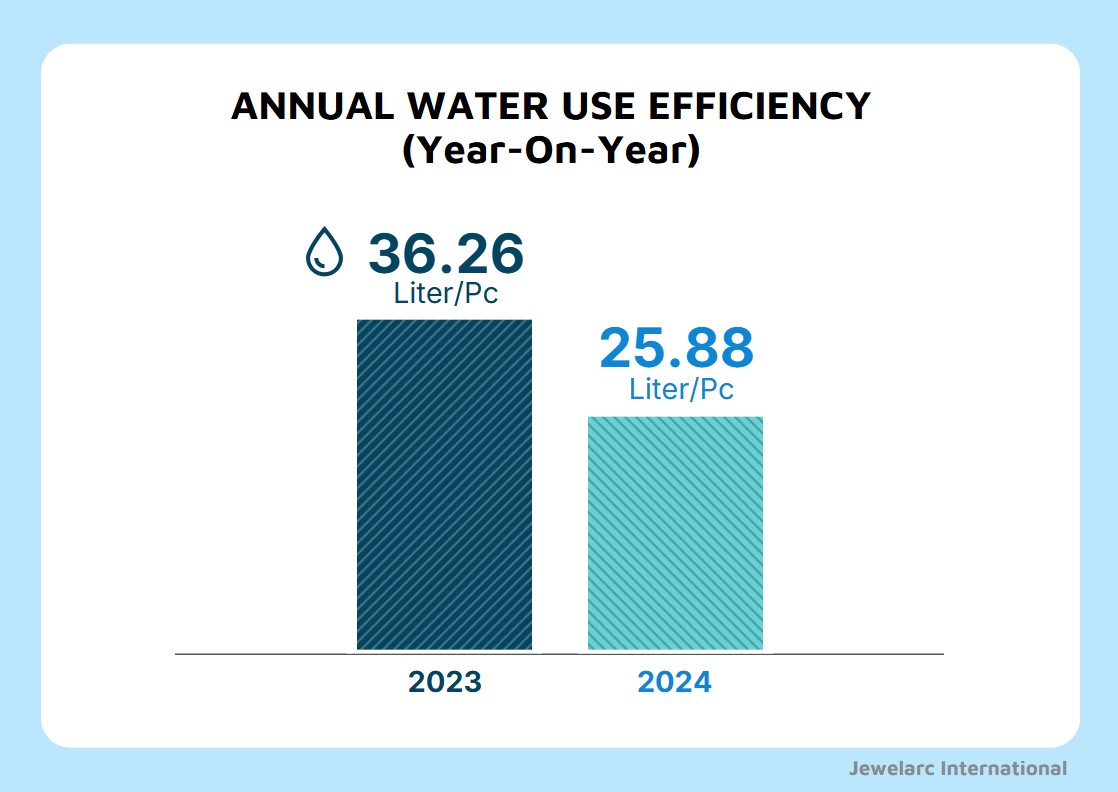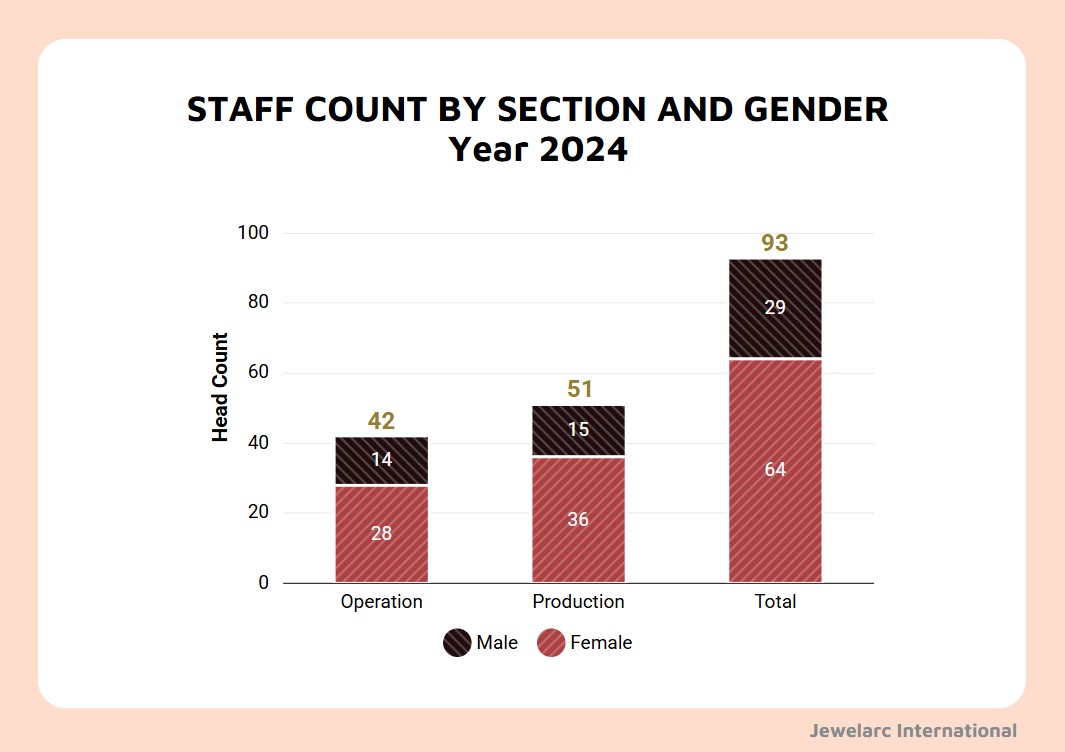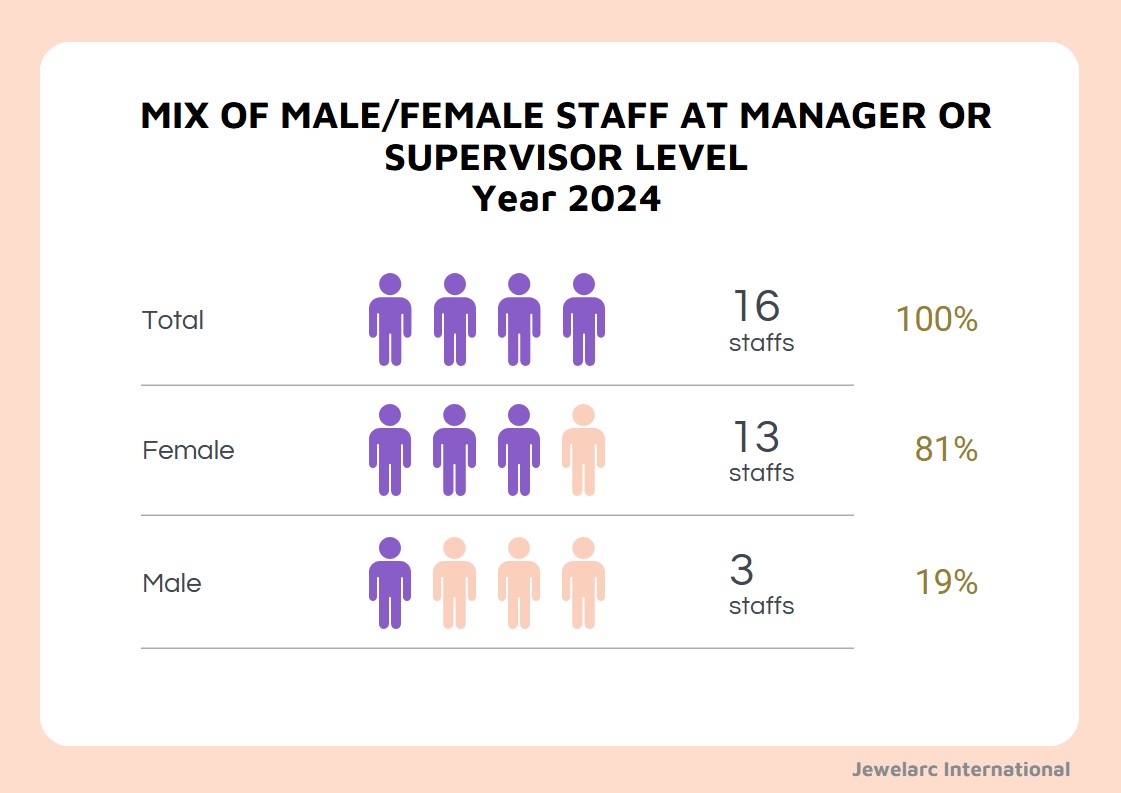SUSTAINABILITY PERFORMANCE
We are devoted to reducing our environmental footprint on this earth and actively monitor our energy and water usage to help guide our reduction efforts, and we then publish the results as below for the world to see.
In addition we are tracking our efforts to reduce the overall volume of waste that we can not recycle or compost on site.
And we are proud of our standing to grant equal opportunity to all staff regardless of their backgrounds, with some simple measures of success being the comparative number of female and male staff on our workforce and those holding senior leadership positions.

- The chart above presents a year-on-year comparison of power usage and production output for the first half of 2024 and 2025.
- In the first half of 2025, overall electricity consumption slightly decreased by approximately 5.7% compared to the same period in 2024, while production output increased significantly by about 73%.
- This significant growth in output alongside reduced energy usage reflects a remarkable 45% improvement in energy efficiency per unit produced, highlighting enhanced process optimization and a strong move toward more sustainable manufacturing practices.

- Electricity is currently sourced from the grid but we are on track with our plans to substantially reduce this reliance via the use of roof-top solar generation to be introduced by the end of 2027

- The chart presents a year-on-year comparison of water usage and production output for the first half of 2024 and 2025.
- Between first half of 2024 and 2025, the company achieved a significant 30% reduction in water consumption, while production output increased by approximately 73% over the same period.
- This shift from 3.31 million liters to 2.30 million liters in water usage, along with the rise in output, indicates a strong improvement in resource efficiency and operational performance.

Waste that we can not recycle or reuse on site comprises the following categories which is monitored and measured and tracked against corresponding waste volumes in the previous year:
- Used investment powder – associated with the casting process
- Used factory consumables – such as cloths, production tissue, polishing powder, sand paper, etc
- Casting tree waste
- Waste recycled offsite – such as glass, metal, plastic, paper and cardboard
- Used toilet tissue – from our bathrooms
- Other general waste – not recyclable
In this year we are also now tracking the volume of waste water from significant production processes and will be able to report comparative results next year.
We are currently not tracking other forms of water leaving our facilities such as rainfall runoff from the roof and grounds, bathroom waste water and general non-collected production waste water.

- The chart compares offsite waste disposal and production output for the first half of 2024 and 2025.
- Waste not included in these figures are food scraps from our canteen and some post-production compostable plastic which are both disposed on-site through an organic composting process producing a rich bio-humus for our gardens and lawns
- While the total amount of waste disposed increased from 5,648 kg to 9,433 kg, production output rose significantly by 73% from 82,100 to 142,054 pieces.
- Despite the higher volume of waste, the waste generated per unit produced has actually decreased, indicating improved efficiency in waste management relative to output. This means that in 2025, the company was able to produce more with less waste per item, reflecting a positive shift towards more sustainable and responsible manufacturing practices.

- The above chart is intended to summarise the major groups of waste which we need to dispose off-site
- Investment Powder is the dominant waste category, accounting for 8,150 kg or 86% of the total waste taken offsite.
- The second largest amount of waste taken offsite is used tissue paper collected from our bathrooms which represents 4% of the total. It is common practice in many Asian countries for toilets to be fitted with bidet-style water sprays. Tissue paper is then used solely for drying and is never flushed. The overall process is simple and regarded by most people as more hygienic than the traditional western style of toileting
- Waste which can be recycled including metal, paper and cardboard comprises 2% or 157.50kgs so far this year
- All other waste disposed offsite is approximately equally comprised of factory consumables, casting tree waste and general waste of around 2-3% each


- For the first half of 2025, Jewelarc employs 96 permanent staff, with 45 people in Operations and 51 people working in Production-based roles
- Jewelarc equally accepts workers of any gender into any role, and they are selected and offered positions based only on their preference, their experience and our requirements at the time
- 68% of the total workforce are female and 32% are male, meaning that females currently outnumber their male counterparts by 2.1:1
- In Operations, the ratio of female staff to male staff is 2:1
- In Production, the ratio is even higher at 2.2:1
- Jewelarc acknowledges and openly accepts and welcomes staff who prefer their gender identity to be non-binary, reflecting the general very high level of acceptance of these people in the wider Thai community. The above figures are based on the gender classification taken from citizen Identity Cards which currently only recognise the two traditional mainstream genders

- 17 of our 96 permanent staff hold positions at the supervisor or higher levels
- 13 out of 17 leaders are female, accounting for 76%.
- The numbers reinforce Jewelarc’s policy of appointing the most appropriate person to each role based solely on each individual’s experience and ability and attitude
- Having more females than males in leadership roles is also a reflection of our policy to promote from within if at all possible, since we employ more females than males in the overall workforce
We are in the process of calculating the carbon footprint of our business operations with a view to continue working towards reducing our net carbon impact on the environment.
We already have a good idea of which parts of our operations lead to the most amount of carbon production, be that directly from what we do internally or what we buy-in and use or consume. Over five years ago we started taking definitive steps to reduce our impact, and the completion of the carbon footprint exercise will further help to expand and focus our efforts in all affected areas.
We accept that atmospheric carbon dioxide is one of the primary greenhouse gases that is contributing to global warming and consequently to climate change at a greater rate than ever. NASA reports that “human activities have raised the atmosphere's carbon dioxide content by 50% in less than 200 years” with the burning of fossil fuels being of major influence.
The problem is that carbon dioxide is being released at a far greater rate than natural and even man-made processes can remove this gas. This and other greenhouse gases in our atmosphere then act as a more efficient blanket or cap which traps more and more of the heat that the Earth might have otherwise radiated out into space.
We believe that taking steps to reduce the amount of carbon dioxide in the atmosphere is the responsibility of all citizens, business units and government bodies.
In a nutshell, we have heavily adopted the principles relating to …

The aim is simple: in our case, to make the same amount of finished goods – or possibly even increasing output - using less resources and producing less waste.
As above, we have already outlined some of the key results of following this philosophy, including our efforts to reuse and recycle, to reduce waste and to reduce our consumption of water and electricity.
To this data we need to comment further in respect of our use of electricity and our carbon sequestration initiative, with both subjects directly related to the reduction of carbon dioxide emissions on account of our business operations.
As previously noted, our only current source of electricity is from the general grid, but with an aim and strategy in place to introduce roof-top solar by the end of 2027 as a source of renewable energy thereby reducing our overall carbon footprint.
Being totally reliant for now on a grid supply, its important to understand Thailand’s general sources of electricity creation because this directly and hugely relates to the amount of carbon dioxide emissions created by those sources on account of our demand for and use of electricity.

Data source: The Energy Policy and Planning Office of Thailand’s Ministry of Energy (https://www.eppo.go.th/index.php/en/en-energystatistics/co2-statistic)
The figures show the amount of CO2 emissions (in grams) associated with the production of 1 kWh of electricity in Thailand, averaged across all energy sources, across the past 26 years.
In this period, Thailand has achieved a 40% reduction in CO2 emissions attributed to ongoing changes in the energy source mix (including the growth in renewable sources) and improvements in technology.
The latest available figure for 2024 is 383g for the generation of 1kWh.
This compares to Australia’s 2023 rate of around 549g, Germany 381g, Canada 171g, New Zealand 112g, Sweden 40g and Norway 30g (Source: Statista.com)
A significant contributing factor to Thailand’s relatively low level of CO2 emissions from power generation is its energy source mix, as follows.

Data source: Electricity Generation Authority of Thailand
The above chart summarises the primary energy sources for Thailand’s power generation, and it can be seen that natural gas accounts for 63% of the mix. While gas and coal are both non-renewable fossil fuels, this high portion of gas in Thailand is significant because its carbon intensity is only about half that of coal. This of course means that jurisdictions with a high portion of coal in their energy mix (such as Australia with 46% coal and 17% gas – source: energy.gov.au)) will proportionally be producing higher CO2 emissions.
The conclusion we draw on the above data over Thailand’s energy mix is that the country is highly active in reducing its level of CO2 emissions from electricity generation and is making consistent solid progress and is competitively positioned when compared to many developed countries in their goal to reduce CO2 emissions.
Carbon sequestration is the process of capturing and storing atmospheric carbon dioxide. It is one method of reducing the amount of carbon dioxide in the atmosphere with the goal of reducing global climate change.
Jewelarc has its own Sequestration Program centred around the ability of trees to remove carbon from the atmosphere, storing it in their branches, stems, leaves, bark and roots. As trees grow, they remove carbon dioxide from the atmosphere through photosynthesis and convert this into carbon to make wood.

Our first initiative in this area is to consider the sequestration ability of the trees and other plants in our own factory compound, since around 40% of our total land area is landscaped gardens and open grassland area with around 20 large mature trees and more than 200 medium and smaller sized trees, shrubs and bushes.
We estimate the total amount of carbon being sequestered from within our compound is 2,180 kgs per year, or the equivalent of driving the average petrol powered vehicle around 8,000 km. While being a solid contribution to offsetting our total carbon footprint we want and need to do more.
Our second initiative involves the replanting of many more trees on selected government and community land around the world. Our plan is to use this project as a means to introduce school students to our sustainability program through education and tree planting activities, thereby helping them learn more about the challenges facing their generation and the wide range of opportunities for them to instigate change and improvements.